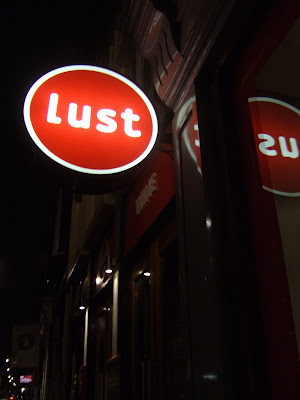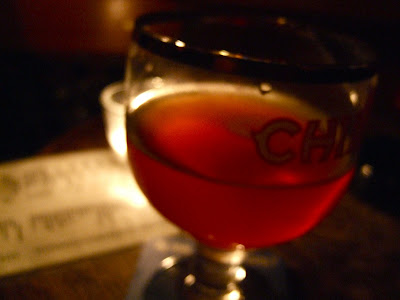
At Museum Platz, with the temporarily closed Rijksmuseum & I (am)sterdam sign.
(Happy Thanksgiving! No turkey-cooking instructions, however. The Faux Gourmet isn't the most seasonal of chefs. But stay tuned for Wine Weekend reports, coming soon. Doesn't that sound better than a turkey?)
Taste & See: Amsterdam may be better known for certain herbs than for its cuisine but on my recent trip a friend & I sampled some great eats.
Days 3 & 4: Our Dutch host recommended to us a cafe serving the best Appeltaart (apple pie) in Amsterdam. Indeed, Cafe Winkel in Jordaan was so jammed with people we had to throw some elbows to get in the door. Granted, a sudden downpour had started minutes before our arrival so it was hard to judge whether the popularity was due to the appeltaart or the rain.

I was utterly unprepared for the rain, and even with a barely-broken umbrella, the gift of a thoughtful vendor in the open market still bustling in the square outside, I was in a sorry state when we finally made it in from the cold. But the appeltaart made it all worth it. As a Dishola reviewer noted:
Thick, soft, dark brown, cinnamoned-apples chunks are lovingly surrounded by tender strudel and topped with fresh-whipped cream in this classic take on the Dutch Apple Pie; Winkel's version is famous and worth the hype. Sitting outside near the open-air market with a coffee and a slice of this is basically paradise in [Amsterdam].Delicious indeed.

Appeltaart, a staple in Dutch cafes (as opposed to coffee shops, which aren't exactly known for their coffee) is very different from American Apple Pie. It has a thick crust up high around the edges and is often stuffed with raisins and flavored with cinnamon and lemon juice. Winkel's version didn't have raisins, but its thick and chewy crust made it taste more like a hardy snack than a sugar rush.

Do it yourself: Appeltaart has been around for a long time; in fact, one appears in a 1529 painting from the Dutch Golden Age. But even the prettiest pies are better to eat than to look at; see for yourself with the following recipes:
Crispy Waffle (with raves from a Dutch gal who tried it, with great results)
My Sister's Kitchen
Dutch Food, on About.com
Taste & See, Continued: Later in the day when man-taste buds kicked in, we joined the throngs munching on great paper cones filled with Fries along the water front of one of Amsterdam's main thoroughfares, where many of the canal tours depart.
Image, Amsterdam Restaurant Secrets.
The fries are delicious, but the name could use some work:

Fries from Amsterdam . . . named for the famous Manneken Pis statue in Belgium. How droll.
Image, Belgium Tourist Information.
Speaking of national foods, a Belgian bakery was busy promoting its baked goods by going back to cultural roots, sort of:

And speaking of cultural roots, the Dutch colonial history makes for some far-flung eateries new to a traveler more accustomed to British & French colonial culinary offerings. I knew the Dutch had colonized both Indonesia and Suriname, only granting Suriname's independence in 1975 (!!), but the pairing of a Surinamese/Indonesian restaurant kind of baffled me. I asked which foods were from which country and the waitress said they're all the same. This made no sense . . . until I thought about the Indians in Kenya.
Like the British, the Dutch responded to labor shortages following the abolition of slavery by importing workers from one colony to another. Hence, the presence of a large Javanese population, part of modern day Indonesia, in Suriname, across the world in South America. Over time the Javanese cuisine (though I don't dare get into the diverse collection of distinct peoples that make up Indonesia here!) morphed with the Surinamese context to form a unique blend.
And hence the presence of Beef Rendang (featured here after last winter's trip to Malaysia) in Amsterdam:

Lamb Curry with a roti-like bread:

Fried Plantains with Peanut Sauce:

The full spread:

Incredible food, one of the best meals we had in Europe!
A bit later we came across this tantalizing restaurant . . .

But don't get your hopes up, lest you were thinking this an outpost of the Red Light District. Lust, in Dutch, simply means appetite.
The lovely, airy Cafe de Jaren was a perfect spot for resting museum-weary feat and taking in a mid-afternoon snack. Below, the tasty fruit beer Mort Subite ("Sudden Death") and a Warm Goat Cheese with Honey and Rosemary. Divine!

And for a final sweet treat, a Waffle laden with sugar, so pretty I could kiss it. Or maybe just eat it with sighs of pleasure.




















